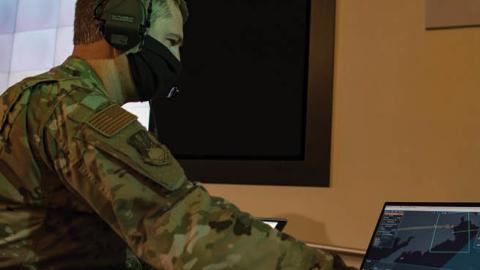If the Pentagon wants a force that can fight jointly, it needs to abandon standards as it knows them.
Since the last National Defense Strategy, senior Pentagon leaders have prioritized enhanced jointness in operations. A special focus has been data-centric digital modernization coordinated by the 150-person Cross-Functional Team for Joint All-Domain Command Control, dubbed JADC2. This CFT has focused on establishing data standards and moving toward an implementation plan. Conventional wisdom says that unless the Joint Staff establishes common standards upfront and enforces them vigorously, service weapons systems won’t be able to collaborate in operations when they finally show up in the field.
The Defense Department’s focus on the technical aspects of joint integration is well placed. The fundamental difference between joint operations today and 50 years ago is that force integration and employment must now also consider machine-to-machine digital integration. Satellite sensors, airborne battle management systems and naval fires weren’t acquired with a requirement to interoperate with each other. The net-ready key performance parameter simply ensured systems were connected to some kind of network. When forces from different military branches show up in theater, they don’t plug and play, and combatant commands simply aren’t equipped with the resources or engineering tools to wire them together.
A prevailing view is that the solution lies in developing data standards and using the requirements process to force military adoption. But this approach makes it difficult to adopt trends from the fast-moving commercial sector, and the historical track record for this concept is poor.
A well-known means of encoding warfighting data like target location over datalinks is the J-series message. These messages are data-centric, with a committee determining how each precious bit should best be used to convey key information. In theory, it is to be used by all services and NATO allies with compliance mandated by joint instructions. But despite an introduction more than 40 years ago, adoption across the force remains incomplete.
Furthermore, standards compliance doesn’t actually drive interoperability — radios from different manufacturers that comply with the standard in theory don’t always interoperate in practice because of implementation differences in rules for passing data. Even with common radios, Link-16 shows its age. It has limited data rates and the tightly defined message types don’t easily accommodate new sensor modalities like radar images. When data is passed over ethernet lines in a command center and not tactical datalinks, getting the data to work effectively together is hard work, as Project Convergence has shown.
With rapidly advancing threats, the department can’t wait around 40 years for a committee to define new standards and services to partially implement them. Perhaps because JADC2 is more reliant on cloud computing than earlier net-centric warfare efforts it has become popular to make analogies between JADC2 and the internet, suggesting that making data standards more flexible or modern or better will somehow make interoperability work this time. But this analogy is misplaced.
The internet, and much of the modern digital world, benefits tremendously from standardization, but uses a completely different approach — known as the reference model — to achieve its effect. There is no omnipotent and omniscient governing standards body, and no requirements process to force adoption. Rather than writing down specifications, this approach focuses on delivering working implementations of an interface or technical concept, and then making that available to a larger group for reuse. In this case, the standard acts as a reference or shortcut to delivering a working product rather than a pass/fail test for acceptability. Incentives, rather than penalties and mandates, drive behavior.
One example of the reference model is the Internet protocol suite, commonly known as TCP/IP, which is the core set of communications protocols used for the Internet, establishing a system of addressing and packets of digital content. While early versions of this were developed by DARPA, TCP/IP started taking off in the late 1980s when the University of California, Berkeley placed its TCP/IP code into the public domain. Microsoft grabbed this code and grafted it in this Windows operating systems, giving TCP/IP a huge leg up over competing and now-forgotten interoperable networking protocols like SNA, XNS and the OSI protocol favored by the DoD at the time. The reference model for standards also works in an additive sense, which is how there can still be hundreds of thousands of dialup connections still in use — changes are incremental and don’t require committee approval.
Complex modern telecommunication systems such as 5G, standardized in a body called 3GPP, also use the reference model. Member companies contribute actual working implementations for evaluation and selection, and receive licensing compensation in return. In addition to saving the time of developers and delivering working results faster, this model sets up two-sided incentives for sharing intellectual property.
The Department of Defense should take a lesson from the 5G community. Rather than spending years of committee work trying to reach consensus on exactly how JADC2 should be constructed, it should move out on delivering working joint capabilities from existing systems for key combatant command needs.
As the best reference implementations, application interfaces, and protocols emerge from this activity, the DoD should foster two-sided incentives, enabling other developers in the industrial base to pick up and use working building blocks. The government has a key role in making reference implementations accessible to other contractors and making sure innovators are compensated, either in initial contracts or post-facto licensing. This shifts industry incentives to sharing working implementations and delivers an organic model for interoperability that can leverage the latest trends in technology.
In a competition with a highly capable and adaptive adversary, defining upfront standards is a losing proposition, and the Department of Defense must shift its mindset and adopt a superior evolutionary model.
Read in Defense News















